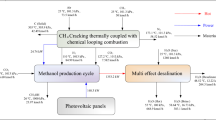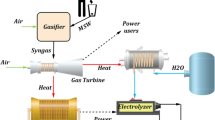Abstract
In this study, we study and evaluate a zero emission integrated system, as taken from the literature, for coproduction of electricity and methanol. The investigated integrated system has three subsystems: water electrolysis, Matiant power plant (oxy-fuel combustion of pure methane), and methanol production unit. The system and its components are analyzed energetically and exergetically. The rates of exergy destructions, relative irreversibilities, and sustainability indexes of each subunit of each subsystem, as well as the overall system are analyzed to identify the greatest exergy losses and possible future research directions. The total rate of exergy destruction of the overall system is calculated to be around 280 MW. The greatest rate of exergy destruction, therefore the greatest irreversibility, occurs within the power plant unit (about 60 % of the total rate of exergy destruction). The energy efficiencies of electrolysis, power plant, and methanol synthesis unit are found to be 30 %, 76 %, and 41 %, respectively. The exergy efficiencies of electrolysis, power plant, and methanol synthesis unit are found to be 30 %, 64 %, and 41 %, respectively. Depending on the utilization of the heat rejected from the different units of each subsystem, the overall system could have energy and exergy efficiencies up to 68 % and 47 %, respectively.
Access this chapter
Tax calculation will be finalised at checkout
Purchases are for personal use only
Similar content being viewed by others
References
International Energy Agency Technical Report (2012) Key world energy statistics. Website: http://www.iea.org/publications/freepublications/publication/kwes.pdf. Accessed 10 Jan 2013
Davison J (2007) Performance and costs of power plants with capture and storage of CO2. Energy 32:1163–1176
Damen K, Troost T, Faaij A, Turkenburg W (2006) A comparison of electricity and hydrogen production systems with CO2 capture and storage, Part A: Review and selection of promising conversion and capture technologies. Prog Energy Combust Sci 32:215–246
Minutillo M, Perna A (2010) A novel approach for treatment of CO2 from fossil fired power plants, Part B: The energy suitability of integrated tri-reforming power plants (ITRPPs) for methanol production. Int J Hydrogen Energy 35:7012–7020
Guang-jian L, Zheng L, Ming-hua W, Wei-dou N (2010) Energy savings by coproduction: a methanol/electricity case study. Appl Energy 87:2854–2859
Chen Y, Adams TA II, Barton PI (2011) Optimal design and operation of static energy polygeneration systems. Indus Eng Chem Res 50:5099–5113
Katayama Y, Tamaura Y (2005) Development of new green-fuel production technology by combination of fossil fuel and renewable energy. Energy 30:2179–2185
Takeuchi M, Sakamoto Y, Niwa S et al (2001) Study on CO2 global recycling system. Sci Total Environ 277:15–19
Mignard D, Sahibzada M, Duthie JM, Whittington HW (2003) Methanol synthesis from flue-gas CO2 and renewable electricity: a feasibility study. Int J Hydrogen Energy 28:455–464
Cifre PG, Badr O (2007) Renewable hydrogen utilization for the production of methanol. Energy Convers Manage 48:519–527
Soltanieh M, Azar KM, Saber M (2012) Development of a zero emission integrated system for co-production of electricity and methanol through renewable hydrogen and CO2 capture. Int J Greenh Gas Control 7:145–152
Perry RH, Green DW (2000) Perry’s chemical engineering handbook, 7th edn. McGraw-Hill, New York, NY
Dincer I, Rosen MA (2007) Exergy: energy, environment and sustainable development. Elsevier, Oxford
Kotas TJ (1995) The exergy method of thermal plant analysis. Krieger, London
Author information
Authors and Affiliations
Corresponding author
Editor information
Editors and Affiliations
Rights and permissions
Copyright information
© 2014 Springer International Publishing Switzerland
About this chapter
Cite this chapter
Acar, C., Dincer, I. (2014). Energy and Exergy Analyses of a Zero Emission Power Plant for Coproduction of Electricity and Methanol. In: Dincer, I., Midilli, A., Kucuk, H. (eds) Progress in Exergy, Energy, and the Environment. Springer, Cham. https://doi.org/10.1007/978-3-319-04681-5_13
Download citation
DOI: https://doi.org/10.1007/978-3-319-04681-5_13
Published:
Publisher Name: Springer, Cham
Print ISBN: 978-3-319-04680-8
Online ISBN: 978-3-319-04681-5
eBook Packages: EnergyEnergy (R0)




